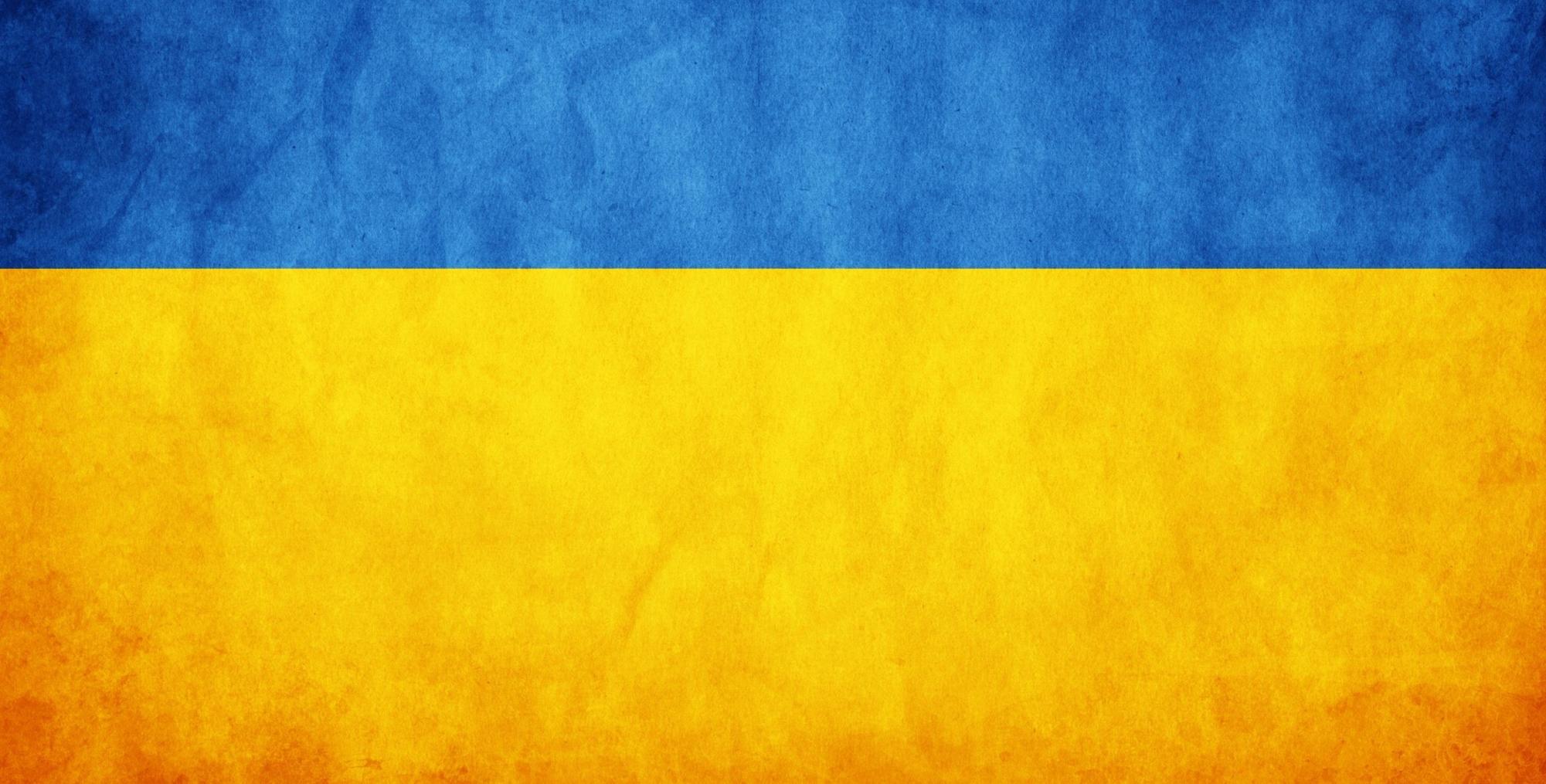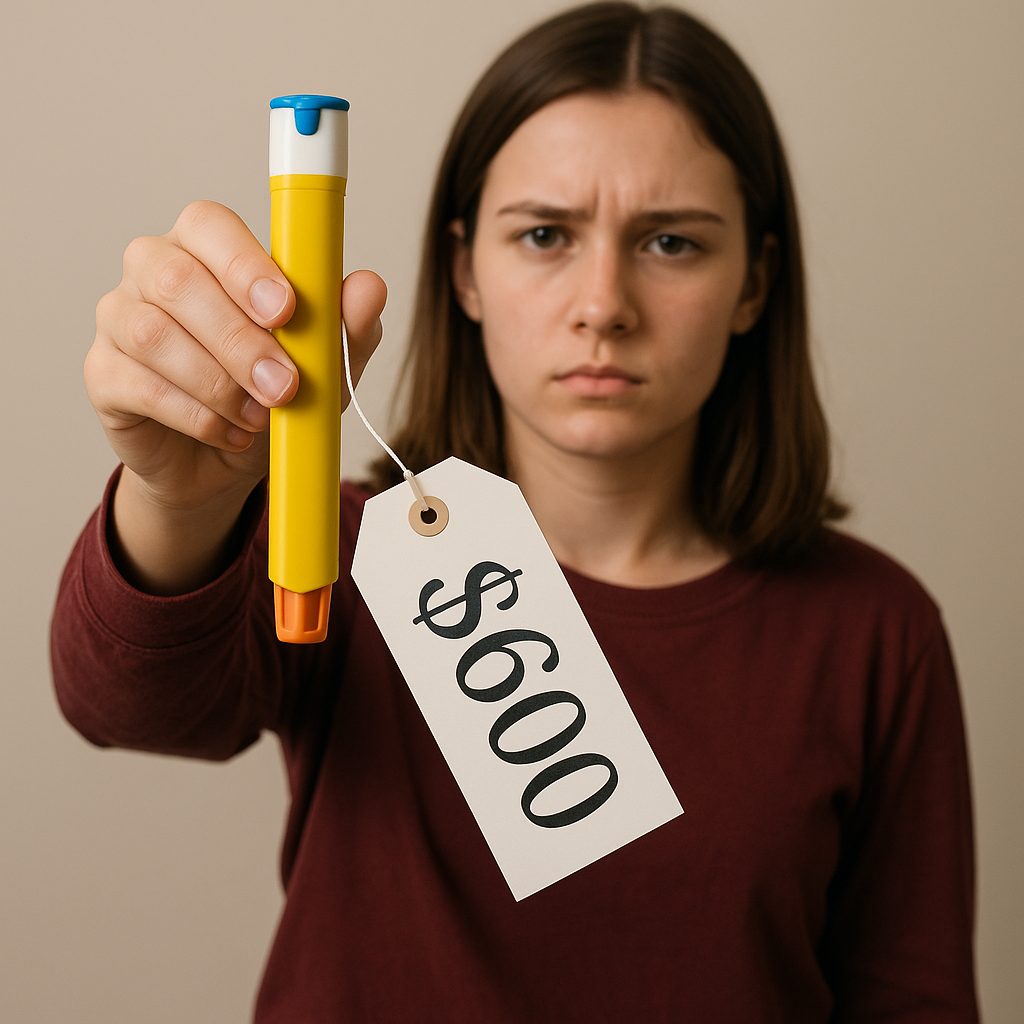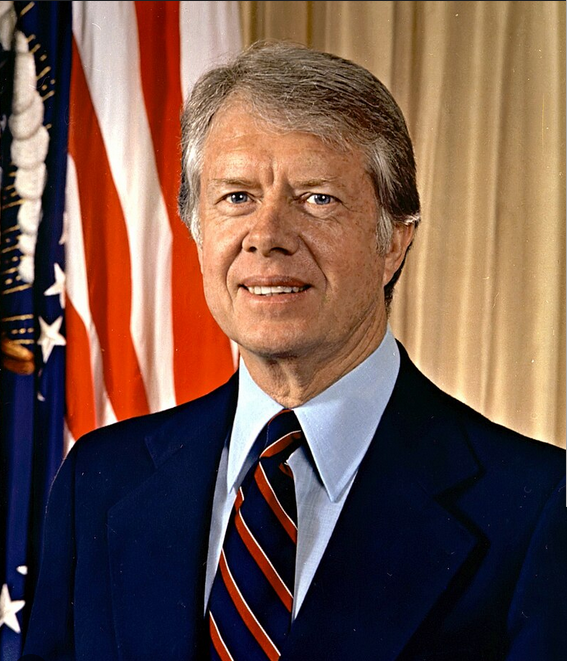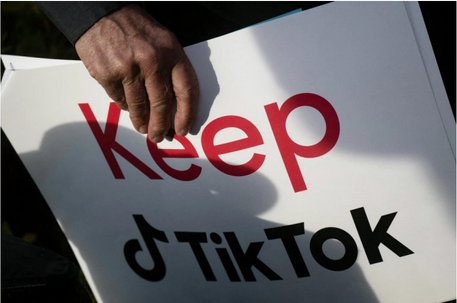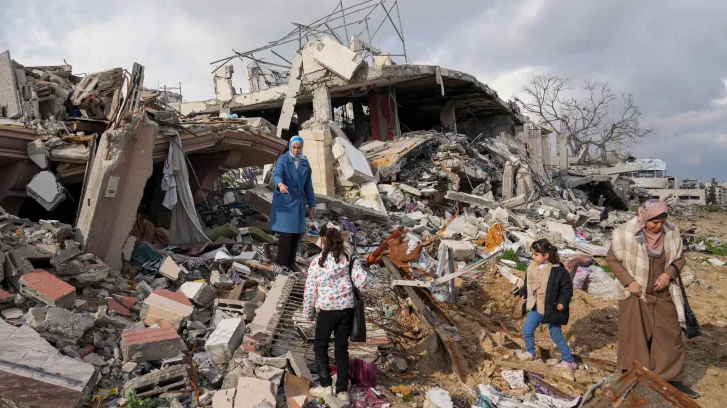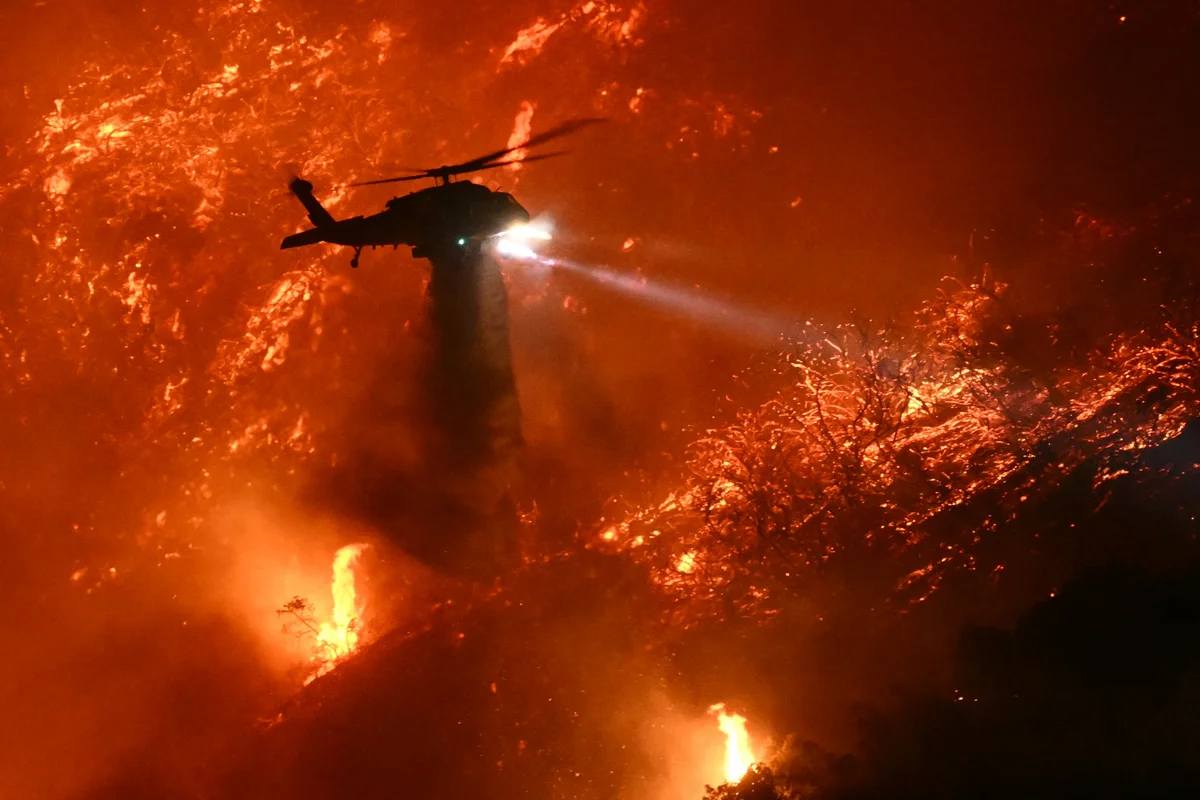The Russo-Ukraine started on February 20, 2014 and eight years later on February 24, 2022, escalated into the Russian invasion of Ukraine. Since the invasion Russia is estimated to have control of about 20% of Ukraine. Late October of 2024 Ukrainian troops reported that Russia has been bringing North Korean troops into Ukraine to fight as Russian allies. Although officials in Moscow and Pyongyang have not responded to the allegations, intelligence officials from Ukraine and South Korea have been able to confirm that there are about 11,000 North Korean troops being deployed to Ukraine, but 100,000 more could be sent in upcoming months. In order to understand why North Korean troops are being deported to Ukraine we must analyze the origins of the Russo-Ukrainian war and the connection between Russia and North Korea.
A Brief History of the Rise and Fall of the Soviet Union:
Russia is infamous for its violent history regarding its leaders. Up until 1917 Russia was ruled by tsars, king-like figures, with Nicholas Romanov II being the last tsar of Russia. Under the rule of tsars Russia became one of the most impoverished nations in Europe due to the high level of corruption and lack of industrialization. Fed up, the Russian people, mainly farmers and factory workers, decided to rebel, protesting their weak government.
The first spark of revolution occurred in 1905 on a day famously known as the Bloody Sunday Massacre. The massacre occurred when workers across the country went on strike to protest low wages and high inflation. The workers went to St. Petersburg, the capital at the time, for a peaceful protest. Infuriated, the tsar had thousands of innocent unarmed people murdered. His actions led to further outcry and it’s during this time that we get the first mention of a soviet, which were groups of workers who came together to fight for the expansion of their rights. The soviets then morphed into the Bolshevik Party, led by Vladimir Lenin. The Russian Revolution of 1917, also known as the October Revolution or the Bolshevik Revolution, was a quick coup of the current government and resulted in Lenin becoming the dictator of Russia. Shortly after the revolution, Russia entered a civil war in which the Romanov family was killed and Lenin became the totalitarian of the established Soviet Union. At its peak, the Soviet Union expanded over 6,800 miles and controlled fifteen countries, with Ukraine being one of the most geographically significant locations in the union. After World War II, in which the Soviet Union and United States were allies, they entered the Cold War. The Cold War was a time of tension between the two world superpowers as they raced to establish who can make better nuclear weapons, go to space, and convert as many countries to their form of government. While the two countries never fought each other directly, they fought proxy wars against each other such as the Vietnam and Korean Wars. When Mikhail Gorbachev came into power in 1985, he instilled the systems of glasnost and perestroika which was a political reform to allow for more transparency as well as personal and economic freedom. After years of economic hardships, Gorbachev resigned as dictator, and on December 26, 1991, the hammer and sickle flag fell and Boris Yeltsin became the first president of the Russian Federation. During this time, all fifteen soviet republics declared their independence.
Ukraine and the Soviet Union
In January 1918 Ukraine declared independence from the Austrian and Russian Empires establishing the Ukrainian People’s Republic. The Ukrainian People’s Republic fought against Russia’s Red Army for three years before being annexed into the Soviet Union in 1922 and became the Ukrainian Soviet Socialist Republic (UkrSSR). Located in Eastern Europe, Ukraine’s geography became important for agricultural production, military operations, and the transportation of Russia’s Black Sea Fleet. Ukraine is well known as the breadbasket of Europe since its fertile soil called chernozem allows for the large-scale production of wheat, barley, and sunflowers, which are used for their oil. In addition to its crops, Ukraine’s Donet Basin is abundant in steel, coal and iron, making the country incredibly valuable to the Soviet Union. Ukraine’s rich natural resources and high population made it the second most powerful republic in the Soviet Union after Russia. Despite the surplus of crops that were produced in Ukraine, the policy of War Communism forcibly removed food from the country to be sent throughout the Soviet Union. This policy resulted in a famine in Ukraine that killed over a million people from 1921 to 1923. After this tragedy, Lenin wanted to increase Ukrainian support for the Soviet Union. In March 1921, Lenin passed the New Economic Policy (NEP) which allowed for greater economic freedom and allowed for the formation of small private businesses and farms. In 1923, Lenin also started a system of Ukrainization, a policy that called for cultural liberalization and the promotion of the Ukrainian language in education, mass media, and government. Because of Ukraine’s resources and large number of workers, many Soviet factories were opened in the republic and Ukraine’s output nearly quadrupled from 1920 to 1941 and they produced almost half of the tanks and missiles for the Soviet Union. The majority of factories were opened in the Donet Basin due to the location’s accessibility to natural minerals and in the central Dnieper area since many crops thrive in the fertile chernozem. In the late 1920’s, Lenin’s predecessor, Joseph Stalin, felt threatened by Ukraine’s autonomy. Stalin took extreme measures to erase Ukrainian culture by preventing the use of the Ukrainian language and used methods such as widespread intimidation, arrests, imprisonment, and even murder to suppress intellectuals, church leaders, and those who had supported pro-Ukrainian policies. Stalin then replaced the NEP with his Five Year Plan which enforced heavy industrialization throughout the Soviet Union and gave the Soviet Union control over Ukraine’s resources, mainly crops and land. During this time, about 80% of Ukraine’s population were peasants who were forced to hand over their land, livestock, tools, and seed to the Soviet Union and work on government collective farms called kolhosps. However, wealthy peasants who were able to own their own land and farms called kulasks, started to rebel. Thousands of kulaks who tried to rebel were shot, arrested, or sent to labor camps known as gulags that were located in Siberia. Part of Stalin’s Five Year Plan called for unrealistically high quotas on wheat and grain, which resulted in one of the largest famines in history, the Holodomor, which translates to “death by starvation”. The Holodomor was a man-made famine that claimed the lives of over four million people. As the famine continued and farmers tried to leave to find food, Stalin closed the Ukrainian borders, isolating Ukraine from the rest of the world. Internal passports were created and prevented farmers from traveling within their own country without permission. Some towns were even surrounded by Soviet troops for not meeting the quotas. The residents of these towns were unable to leave and were often harassed by the soldiers. Soldiers would come into people’s homes in search of illegally gathered grain and arrest or kill anyone found to be hiding even a handful of food. In order to escape starvation, people would eat grass, acorns, and even cats. Some desperate farmers even turned to cannibalism. It is estimated that at the peak of the Holodomor in June 1933, 28,000 people were dying a day. During this time, Soviet records show that they took enough gain out of Ukraine to feed ten million people.
North Korea and the Soviet Union
After Japan’s surrender in World War II, the United States and the Soviet Union decided to split the Korean Peninsula along the 38th parallel. By this time many Asian countries including Vietnam and China were turning communist and the United State wanted to prevent Korea from doing the same, this was a theory known as the domino effect. In fact, America was so set on containing communism that the report NSC-68 called for the United States to use military force to contain communist expansionism regardless of where in the world it is occurring. In order to contain communism, the United States started to support South Korea, led by Syngman Rhee, while the Soviet Union supported North Korea, led by Kim Il Sung. In contrast, the Soviet Union wanted to spread their influence across the world and on February 14, 1950, the Soviet Union and China signed the Sino-Soviet Treaty of Friendship, Alliance and Mutual Assistance. This treaty created a mutual defense pact in Asia and promised to provide weapons if one country was attacked by Japan or a Japanese Ally. The Korean People’s Army (KPA) was created in February 1948 and was a group of North Koreans, many of whom were part of the former Chinese People’s Liberation Party. The KPA was funded by the Soviet Union and by 1950 contained about 135,000 men. Even before the war started, over 10,000 soldiers on both sides were killed over border disputes. On June 25, 1950, the KPA advanced into the south, starting the Korean War. The KPA quickly pushed South Korean and American troops to the port of Pusan. During this first phase of the war the South Koreans decided to treat the war defensively and their primary goal was to push the KPA out of South Korea. That summer was one of the driest summers in Korean record and the South Korean and American soldiers resorted to drinking water from contaminated rice paddies resulting in thousands of soldiers dying from diseases. Towards the end of the summer, General Douglas MacAuther, who was the American commander, turned the war into an offensive one. This was initially successful as South Korean and American troops pushed the KPA north towards the Yalu River, which separates China from the Korean Peninsula. However, Mao Zedong, the dictator of China, feared an attack on China and warned the Americans not to get closer to the Yalu River. While President Truman respected China’s warning and worked out other war strategies, MacAuther called to expand the war and suggested bombing bridges that connected China and North Korea. He was fired. After many negotiations, the Korean Armistice Agreement was signed on July 27, 1953 and established a 155 mile long demilitarized zone that separated the two Koreas. After the war, the Soviet Union provided economic support to North Korea and Kim Il Sung became inspired by Soviet methods of retaining power and control.
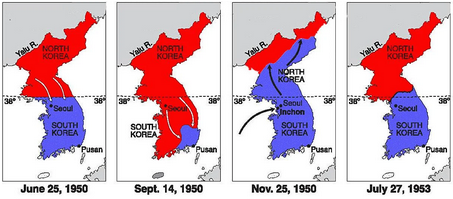
Ukraine After Independence
After the fall of the Soviet Union 92% of Ukrainans voted to become independent and Leonid Kravchuk became Ukraine’s first president. On January 14, 1994, the presidents of Ukraine, the United States, and Russia signed a trilateral statement that Ukraine would transfer all strategic nuclear warheads to Russia and disarm former soviet launchers in the country with American aid. In return Russia will compensate Ukraine for the uranium used in the warheads. Once Ukraine removed all nuclear weapons and signed the Nuclear Nonproliferation Treaty (NPT) which they did in 1994. After Ukraine signed the NPT they signed the Budapest Memorandum on Security Assurances and were recognized as an independent nation that will not be threatened by Russia, America, and Britain. NATO’s Partnership for Peace (PfP) was established in January 1994 to ensure peace and security between NATO members and non-members, primarily those that were once part of the Soviet Union. Shockley, Russia was the first nation to join the PfP although they were suspended on April 1, 2014. On February 8, 1994, Ukraine joined the PfP and has since pushed to become a NATO member. Years later in 2008, NATO started to offer Ukraine Membership Action Plans (MAPs), but declined due to Russia’s opposition. Separately, Putin told U.S. President George W. Bush that Ukraine is “not even a real nation-state.”On July 10, 1994 Leonid Kuchma won the presidential election and his term was full of numerous economic crises, corruption, and scandal. On September 16, 2000, journalist Georgiy Gongadze went missing while investigating the corruption occurring in Kuchma’s administration. Two months later on November 3rd, his beheaded body was found 70 kilometers away from Kyiv. Shortly after Gongadze’s death, tapes emerged of Kuchma talking about how Gongadze had to be dealt with, however, he was never charged with the murder since he never explicitly stated to kill him. The controversy, known as the cassette scandal, resulted in mass protests around Ukraine. In January 2016, Oleksiy Pukach, the ex-head of the Interior Ministry of Ukraine’s surveillance department admitted to the murder and was sentenced to life in prison. In 2004 Ukraine was in another election year with the pro-Western Viktor Yushchenko against the Moscow supported Viktor Yanukovych. That September, Yushchenko was the victim of an attempted murder by dioxin poisoning. He survived the attempt but was left with a damaged pancreas and facial deformities. There were two rounds of voting and Yanukovych won both. The Orange Revolution started when protesters took to the streets wearing orange, Yushchenko’s colors, demanding a revote. In December a revote declared Yushchenko the president of Ukraine. Angered with the election results, Russia cut off all gas in Ukraine two years later. Many European countries import Russian gas, and 80% of their gas is imported through Ukraine. This resulted in a supply drop and unveiled Ukraine’s economic dependence on Russia. In 2010, Viktor Yanukovych won the presidential election promising closer ties to the EU. However, he severed ties with the EU which resulted in mass protest in Kyiv which led to Yanukovych fleeing to Russia.
Russo-Ukrainian War and Invasion
Crimea is a peninsula on the northern coast of the Black Sea where the majority of residents are ethnically Russian. Putin claimed that these ethnic Russians were being threatened with violence from officials in Kyiv. From February 20 to March 21, 2014, Russian troops, called Little Green Men, wore green uniforms and no identifying patches and surrounded the airports and government buildings. The Russians claimed Sergey Aksyonov, who was the leader of the Russian Unity Party, to be Crimea’s prime minister. On March 6th the Crimean parliament held a likely rigged vote to see if Crimea should separate from Ukraine and join Russia with 97% of people choosing to join Russia. That May, it was discovered that only 30%-50% of people voted with just over half picking to become a part of Russia. On March 18th, Putin, Aksyonov, and other parliament members gathered to sign a treaty to incorporate Crimea into Russia. Hours after the treaty was signed, a Ukrainian soldier was killed by masked Russian gunmen at a military base outside Simferopol, a major city in Crimea. Russian troops continued to occupy Ukrainian military bases in Crimea forcing 25,000 Ukrainian soldiers to relocate. The rest of the world watched in horror and responded by freezing Russian assets and travel bans. On March 21st, Putin officially passed laws allowing Crimea to be a part of Russia. Yatsenyuk spent this time negotiating with the International Monetary Fund (IMF) for an $18 billion loan to help pay for austerity measures such as the reduction of gas prices and protect the value of the Ukrainian currency, which is called the hryvnia. As Russia continued to expand though Crimea, they charged Ukraine 80% more for gas. By late March, Russia stated that they had no future plans to attack Ukraine. However, in early April, NATO press briefings revealed that there were about 400,000 Russian troops at the Russian-Ukraine border. Eastern cities in Ukraine started to be attacked by Pro-Russian gunmen. In the eastern city of Slov’yansk, a gun battle broke out when these gunmen started to block public roads. Although an emergency peace meeting was held in Geneva, the assaults on Ukraine only exacerbated. Much to how Stalin silenced his enemies by murdering them, murders and mysterious disappearances became a common way for Putin to silence powerful Ukrainians. A Horlivka city council representative named Volodymyr Rybak was kidnapped and killed by the Little Green Men. Eight members of the Organization for Security and Co-operation in Europe (OSCE) mysteriously went missing along with dozens of journalists and security service personnel. Gennady Kernes, the mayor of a city called Kharkiv, reversed his pro-Moscow standing and supported Ukraine. He was hunted down and was seriously wounded by a sniper. By the end of April, the regions Donetsk and Luhansk declare themselves independent republics. May 25th was another election year for Ukraine with billionaire Petro Poroshenko winning with over 50% of the votes. The results of the elections were faced with extreme violence. Mobs of pro-Russian separatists were killed and a Ukrainian helicopter was shot down, killing all fourteen people. Unfortunately, this was not the only attack on aircraft. On July 14 a Ukrainian transport plane was shot down. Two days later On July 14 a Ukrainian fighter plane was shot down 20 kilometers from the Russian border. On July 17 Malaysia Airlines 777 was heading to Kuala Lumpur from Amsterdam carrying 298 people when it crashed. Later, U.S. intelligence analysts confirmed the plane was brought down by a Russian made surface-to-air missile. On September 5, 2014, the first glimpse of hope could be seen when the Minsk Agreement was signed. This agreement was aimed to end the fighting but was unsuccessful. On February 11, 2015, the Second Minsk Agreement was signed, but like the first one, it was unsuccessful. On April 21, 2019, Volodymyr Zelensky became president. He was a former comedian who promised to end corruption, poverty, and the war. In 2021, Zelensky cracked down on Pro-Russian television, banning three stations that were spreading misinformation about the war. Putin deemed this to be an attack on Russia and uses it to justify his actions. After the Kremlin recognized Luhansk and Donetsk as independent in February 2022, Putin has been increasing the amount of troops there in hopes of spreading his Russian influence across Ukraine and starting the invasion of Ukraine.
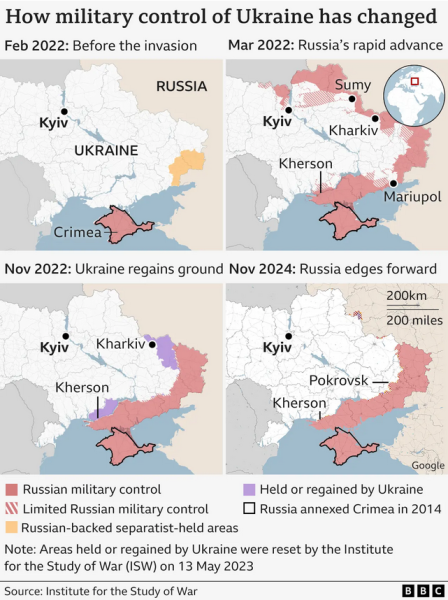
Why Would Putin Use Proxy Soldiers?
Proxy soldiers are armies that are hired by a country to fight. Because proxy armies aren’t used during the full war, they are more cost effective or because the country can’t be blamed for the fighting. Russia has a history of using proxy soldiers mainly in the form of private military companies, such as the Wanger Group. The Wagner Group was founded by Yevgeny Prigozhi in 2014 and it is believed that they have military bases in Southern Belarus. In April 2022 members of the group were accused of torturing three Ukrainian civilians outside of Kyiv. Due to the Soviet Union’s strong connection to North Korea, it is only natural that Putin and Kim Jong Un would also have a close relationship. In fact, in February 2022, at the start of the invasion. Kim Jong Un was one of the few who supported Moscow’s actions in Ukraine. On November 21, 2023, South Korean officials stated that Russia was providing North Korea with the technology that made it possible for the North Koreans to send their first spy satellite into space. North Korea has also been sending Russia supplies for the war effort. The UN was able to confirm that Russia has been using short-range ballistic missiles sourced from North Korea in multiple strikes against Ukraine. With their political relationship, it would make sense that North Korean troops would come aid the Russians. South Korea’s defense minister, Kim Yong-Hyun, discovered that the North Koreans will likely be sent to the most dangerous parts of Ukraine in order to preserve Russian lives. Since North Korean soldiers are trained to fight in a mountainous climate, there is a question of how well they will be able to perform in Ukraine’s flat open terrain. The first troops likely came around late October or early November and it is estimated that there are currently up to 12,000 North Korean troops in Ukraine. Annalena Baerbock, who is Germany’s foreign minister, believes that by using North Korean troops, Putin is spreading the war’s influence into Asia. This theory does make sense as many of the drones and other equipment used were gifted by China. By using troops from the neighboring country, it would help spread Russian influence across Eastern Asia. Zelensky recently announced that some North Korean soldiers have been killed in the war. Ants Kiviselg, head of the Estonian Defense Forces Intelligence Center, believes that because of how different Ukraine’s terrain and climate is compared to that of North Korea’s, the soldiers lack of experience will mean that they will suffer greater losses.
